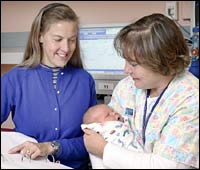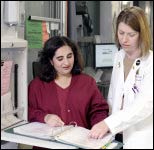Department of Pharmacy: Indispensable Partners, a Multidisciplinary Approach to Medicine
From Hopkins Nurse, Volume 18, Number 2, Fall 2006

Indispensable Partners
It's Monday morning on the medical intensive care unit, and here comes an unneeded bag of amiodarone. Nurse clinician II-M Leah Dickerson, who's already given her patient the prescribed bolus of the antiarrhythmic, marks the medication for return to the pharmacy. But, unwilling to simply let it go at that, Dickerson takes an extra few seconds and walks to a computer work station near the back of the MICU.
"Just FYI," she begins. No rancor. No attitude.
Leah Trimble, the unit's point of care pharmacist, is in the thick of double-checking the morning's medication orders and ensuring that they're entered correctly in the pharmacy computer, but she immediately turns her attention to Dickerson. Then, toggling to a different view on her monitor, Trimble nails the amiodarone problem and calls the Carnegie 6 pharmacy one floor below. Matter of factly, she points out the importance of checking an order's date, a reminder that the rookie pharmacist there is now unlikely to ever forget.
On a 16-bed unit where 90 percent of the patients are intubated, where medication orders average nearly 100 per day and using every central line port is routine, this nearly invisible incident might seem to be the nth degree of trivial. And that, says nine-year veteran MICU nurse Shilta Subhas, is exactly the point: "I remember what it was like not to have a point of care pharmacist here—I would have to talk to five people to get the same result Leah Trimble gets with one quick call."
By 1999, the same year the Institute of Medicine issued its report on the high incidence of medical errors and cited better communication among caregivers as a prime remedy, Hopkins was already moving away from the old "pharmacist-in-the-basement" model that had prevailed as long as anyone could remember. Adopting instead a decentralized approach, the Hospital, medical staff, and departments of Pharmacy and Nursing joined forces to redesign pharmacists' roles in the highly complex medication use system and bring their knowledge directly to the bedside. Nurses "got it" instantly.
"We embraced our point of care pharmacist with open arms," says Subhas. "Getting the drugs we need here used to be a huge issue, and every time you don't have a drug for your patient, it's extremely frustrating. Now, the right drug gets to the right patient much faster."
One reason Leah Trimble and Hopkins' 22 other point of care pharmacists are so adept at smoothing drug-delivery glitches is that, in addition to their roles covering one to three units during the week, they also work every third weekend and some nights in one of the Hospital's eight inpatient pharmacies. And with a foot in each domain, they know firsthand the issues facing both nurses and pharmacists. "Missing doses are a standard problem," says Trimble, "and there isn't one, easy solution." The pneumatic tube used for speeding stat deliveries from pharmacy to unit, for example, seems on occasion to have a mind of its own. "Pharmacy sends the order," Trimble says, "but it doesn't show up, and no one knows where it went." The new Eclipsys provider order entry system, which eliminates handwritten orders and the slowdowns they can cause for Pharmacy, also has quirks. One, says Trimble, is that it defaults to certain times, and if prescribers aren't specific, it could be six hours before the drug arrives. To prevent these and other delays from interfering with patient care, Trimble has been known to sprint to the pharmacy and retrieve the needed medication herself.
 MICU point of care pharmacist Leah Trimble helps nurses provide safer, quicker care.
MICU point of care pharmacist Leah Trimble helps nurses provide safer, quicker care.Yet her trouble-shooting to keep nurses off the phone is only part of the benefit. "There's a subset of medications that MICU nurses use all the time," says Subhas, "but many of our patients not only have the acute medical problem that brought them here but ongoing diseases such as diabetes or congestive heart failure as well. So we do take care of patients who would more typically belong on the cardiac unit or neuro ICU. That's when we really rely heavily on the pharmacist."
Questions span the expected gamut—dosing, side effects, compatibility, monitoring—but also go to tough administration issues: Can we switch from IV to oral? Can this be crushed and given through a nasogastric tube? Being on hand to actually see the patients and talk to the nurses face to face means that Trimble can tailor her answers on the spot. Her proximity also builds trust. "The nurses use me a lot," Trimble says. "We have a good rapport. They know they can ask me anything."
Perhaps nowhere in the Hospital is hand-in-glove collaboration between Nursing and Pharmacy more evident than on the 45- bed neonatal intensive care unit. Patients here can weigh as little as 500 grams; their conditions range from the lung disease and gastrointestinal problems typical of prematurity to cardiac and surgical issues, GI anomalies, sepsis and hypoxic ischemic injury. Their medication requirements are unique, even for the Children's Center.
"Our doses are so small, so different from everywhere else," says nurse clinician III Schelly Webber. "We have to be meticulous in checking and double-checking everything, no matter what the computer says."
Because the pediatrics pharmacy sits right around the corner and was Carol Wesolowski's home base for most of her 16 years at Hopkins, she began functioning as the NICU's point of care pharmacist even before the role was formalized. "There's always been a close relationship," says Webber, herself on the job for 19 years. "Carol is a tremendous resource. She's very familiar with what we need and she makes sure that we get it. If I had to start a dopamine drip right now, I could speak to Carol and know it would be taken care of instantly."
Wesolowski spends most of her time on the unit, processing medication orders and fielding questions from nurses and physicians that range from simple missingdose requests to complex inquiries concerning IV compatibility, dosing and metabolism. Yet policies and procedures, which she reviews with Nursing to assure accuracy and improve the safety of drug administration, are also among her prime responsibilities. "I'm always looking for ways to improve things," she says, "and make it safer for the babies. The unit joined with Pharmacy to put together a handy reference on drug compatibilities, for example, and in a three-way team effort involving physicians, nurses and pharmacists came up with a solution for working with a morphine drip calculator program that was geared toward doses more typically used in older children.
"In nursing school, pharmacology was part of what I learned," says Webber. "So I really rely on Carol to help make the system work the way it needs to—it's a very collaborative process."
Still, the benefit to patients doesn't come only from the knowledge that pharmacists bring to the equation. Decisions that Wesolowski makes every day in the NICU, she says, are informed by the insights the nurses readily share: "It's seeing the set-up of that particular baby and talking face to face that helps me make better pharmacologic decisions. I could give an answer from a book without getting feedback from the nurse, but it might not be the best answer for that particular baby. NICU nurses help me know the patients, and that helps me do my job better."
Let's Talk About It
 Shilta Subhas and Annette Rowden confer on the MICU.
Shilta Subhas and Annette Rowden confer on the MICU.When clinical pharmacy specialist Annette Rowden joined the medical intensive care unit in spring 2000, her deep knowledge of drug actions and interactions quickly earned the respect of the physicians she began rounding with every morning. No question they put to her was too tough. "What they didn't expect," she says, "was that I had questions for them. I think they were a little surprised."
The Hospital's determination to provide safer care, coming as it does amid a nationwide shortage of both nurses and pharmacists, has prompted increasing recognition that the old, separate silos of medicine, nursing and pharmacy aren't in patients' best interests. Rowden is one of about 18 clinical pharmacy specialists at Hopkins— some working exclusively on a single unit, as she does; others covering an area such as pediatric oncology—who've completed specialized pharmacy residencies and are experts in the therapeutic use of medications. Her daily presence, says Shilta Subhas, MICU clinical nurse specialist and facilitator of the unit's Clinical Practice Committee, brings an invaluable dimension to even the thorniest of medication use issues. Working with physician members of the committee, for example, Subhas and Rowden have helped create or revise protocols for administering heparin, insulin drips, activated protein C for sepsis, and sedation, which is ordered for some 90 percent of MICU patients.
"Annette's input is tremendous," Subhas says. "She also helps us figure out the best way to get the drugs here, which ones we should stock. We've learned a lot about how Pharmacy works."
And Rowden, who championed the practice of the MICU's nurses presenting during multidisciplinary patient rounds, is quick to point out that the learning is mutual. "Pharmacy will never know as much about the actual status of the patients as the physicians and the nurses," she says. "The nurses are the ones who can give an upto- the-minute summary. Everything they say is important."
